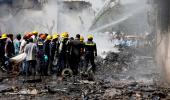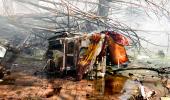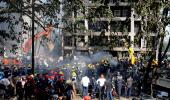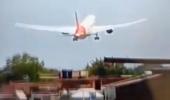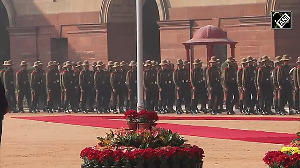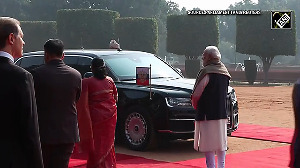'In 50 seconds, the pilots were fighting drag, trying relight, throttling up and avoiding obstacles.'
'They had neither height nor speed. There was no margin.'

India witnessed its first fatal crash of a Boeing 787 Dreamliner on Thursday afternoon when Air India Flight AI-171, from Ahmedabad to Gatwick airport in London, plummeted barely a minute after takeoff.
The aircraft, which had flown in safely from New Delhi just hours earlier, crashed into a hostel for medical students in the densely populated neighbourhood of Meghani Nagar, leaving wreckage strewn across rooftops and streets.
Eyewitness videos showed the undercarriage still down, the nose pitched upward -- indicating dangerously low speed -- before the aircraft plunged into residential structures.
In this interview with Prasanna D Zore/Rediff, Air Marshal Sanjeev Kapoor (retd) breaks down what likely happened in the final 50 seconds: A suspected engine thrust failure, perhaps due to bird ingestion, and a desperate cockpit struggle with no altitude or speed to manoeuvre.
The air marshal cautions against hasty conclusions and stresses the need for thorough recovery of the black boxes and forensic validation. The Dreamliner, with its stellar safety record, he says, must not be indicted prematurely.
Based on preliminary information like the Mayday call and the aircraft's loss of contact at around 625 feet, what technical failure might plausibly have triggered this crash?
It's too early to say. It's too premature. But all the videos and the flight path indicate that a technical malfunction has taken place. That means the engine lost thrust.
Now, it could be engine failure, it could be bird ingestion, it could be an engine fire, it could be the breaking up of any shaft or a mechanical failure inside the engine. It could even be a fuel cut-off to the engine. The inquiry will reveal that.
The aircraft just meshed into the ground from about 400-odd feet above surface (Ahmedabad is 200 feet above the sea level). It didn't have enough power to continue ascent.
From the videos, we can see the undercarriage is still down. That adds to drag. The pilot may have been busy controlling the airplane after the Mayday and lost control near ground.
The aircraft speed also appears to be just at unstick speed (aviation language meaning 'the minimum speed at which an aircraft can lift off (or 'unstick') from the runway during takeoff').
The altitude of the aircraft indicates it was slow. The nose is up -- typical of low-speed flight. With no height and no speed, manoeuvrability was gone. There was no turning back or returning to land. They had no margin.
So how much time did the pilots really have from the moment the emergency began?
The whole thing -- from the highest point to impact -- must have lasted 45 to 50 seconds. Based on ADS-B data (ADS-B stands for Automatic Dependent Surveillance Broadcast, a modern air traffic surveillance technology used for tracking aircraft in real time; ADS-B automatically transmits an aircraft's position (via GPS), altitude, speed, heading, vertical rate of climb or descent, call sign and other flight data), it reached around 425 feet and then descended at 475 feet per minute.
So in those 50 seconds, the crew would have tried to get emergency power, attempted engine relight ('trying relight' refers to the pilots' attempt to restart a jet engine in-flight after it has lost power or flamed out), full throttle, avoided obstructions, run checklists -- all in parallel.
These are SOPs they (all pilots) train for, but I don't think they had the time (to follow all these SOPs in just 45-50 seconds).
This is the first-ever fatal crash of a Boeing 787 Dreamliner. What does that say about the aircraft's systems and design?
You can't jump to conclusions. This aircraft had just flown from Delhi to Ahmedabad. That rules out sabotage and many types of malfunction. The 787's Rolls-Royce engines are among the best -- powerful, very safe.
For both engines to fail, one possibility is simultaneous bird ingestion. You remember the movie Sully -- both engines gone due to birds (The film Sully, starring Tom Hanks as Captain Chesley 'Sully' Sullenberger released in 2016 is based on the real-life event that occurred on January 15, 2009 -- known as the 'Miracle on the Hudson' -- when US Airways Flight 1549 made an emergency landing on the Hudson river in New York after both engines failed due to a bird strike. All 155 people on board survived).
Ahmedabad has large bird activity, especially thermals in summer. Eagles, vultures -- it's a hazard.
[Note: In summer, Ahmedabad's high ground temperatures generate strong thermals -- rising columns of warm air -- that large birds like eagles, vultures, and kites use to soar without flapping their wings. These birds circle within thermals to gain height, making them especially active in the afternoons. When this activity occurs near airports, it significantly increases the risk of bird strikes, particularly during takeoff and landing, when aircraft operate at lower altitudes and are most vulnerable.]
And yes, a whistleblower raised concerns about Dreamliner production. That has to be investigated. Once the black boxes -- the CVR (Cockpit Voice Recorder) and FDR (Flight Data Recorder) -- are recovered, they'll tell us if any of those warnings were relevant. But as of now, the airplane had a proven flight just before. That counts.
What's the standard investigation process now? How does the DGCA proceed?

Actually, it's not the DGCA but the Aircraft Accident Investigation Bureau (AAIB), which is independent and under the ministry of civil aviation. They have technical experts, pilots, engineers, sometimes even Indian Air Force officers (to guide them in such investigations). It's a scientific, tedious process.
First, they cordon the site. The black boxes are top priority. They're not black -- they're orange for visibility -- and are placed at the tail end, which often survives.
In the videos, you can see the tail hanging off a building. Recovery teams would have rushed to that. Decoding the CVR and FDR will take weeks -- maybe months. But that's where real answers lie.
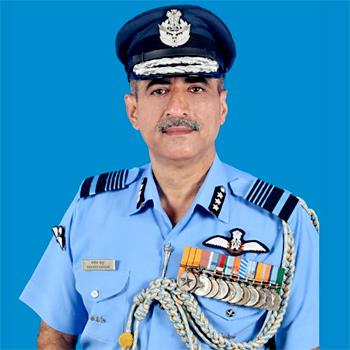 IMAGE: Air Marshal Sanjeev Kapoor (retd). Photograph: Kind courtesy Air Marshal Sanjeev Kapoor/Linkedin
IMAGE: Air Marshal Sanjeev Kapoor (retd). Photograph: Kind courtesy Air Marshal Sanjeev Kapoor/LinkedinThe aircraft was fully fueled for a long haul flight to London. How does that affect the crash's severity?
Very few people know this, but aircraft performance depends on three things: Weight, altitude, and temperature.
In this case, altitude was favourable -- Ahmedabad is just 200 feet above sea level. But temperature and weight were challenging. It's summer, runway temperature easily hits 45°C.
Aircraft was fully loaded with passengers and up to 126 tonnes of fuel. That affects thrust margins.
[Thrust margins refer to the excess engine power available beyond what is minimally required for a particular phase of flight -- especially during takeoff. High thrust margin means the aircraft has extra engine power to compensate for issues like engine failure, drag (e.g., landing gear still down), wind shear, or heavy weight. Low thrust margin means the engines are operating close to their limits, leaving little room for error or recovery in case of a malfunction)].
But to be clear, this wasn't an overload. Aircraft wouldn't take off unless (all these parameters that affect thrust margins were) within limits. But hypothetically, if temperature was lower or weight (of the aircraft, including that of fuel) less, recovery chances might've improved.
Still -- this doesn't mean weight or heat caused the crash. They just reduce your room to manoeuvre if something goes wrong.

